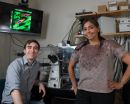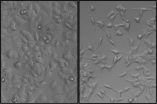Study shows how breast cancer cells break free to spread in the body
2014-12-17
(Press-News.org) More than 90 percent of cancer-related deaths are caused by the spread of cancer cells from their primary tumor site to other areas of the body. A new study has identified how one important gene helps cancer cells break free from the primary tumor.
A gene normally involved in the regulation of embryonic development can trigger the transition of cells into more mobile types that can spread without regard for the normal biological controls that restrict metastasis, the new study shows.
Analysis of downstream signaling pathways of this gene, called SNAIL, could be used to identify potential targets for scientists who are looking for ways to block or slow metastasis.
"This gene relates directly to the mechanism that metastatic cancer cells use to move from one location to another," said Michelle Dawson, an assistant professor in the School of Chemical and Biomolecular Engineering at the Georgia Institute of Technology. "If you have a cell that overexpresses SNAIL, then it can potentially be metastatic without having any environmental cues that normally trigger this response."
The study was sponsored by the National Science Foundation (NSF) and was published December 9 in the Journal of the Federation of American Societies for Experimental Biology (FASEB).
Previously, Dawson and Daniel McGrail, the lead author on the new study, published a study showing how ovarian cancer cells respond to the mechanics of their bodily environment. Their data showed that ovarian cancer cells are more aggressive on soft tissues - such as the fatty tissue that line the gut - due to the mechanical properties of this environment. The finding is contrary to what is seen with other malignant cancer cells that seem to prefer stiffer tissues.
In the new study, the researchers show how overexpression of the gene SNAIL in vitro allows breast cancer cells to operate independently of the mechanics of the environment inside the body. Growing evidence suggests that cancer cells metastasize by hijacking the process by which cells change their type from epithelial (cells that lack mobility) to mesenchymal (cells that can easily move). In the new study, the researchers examined the biophysical properties of breast cancer cells that had undergone this epithelial to mesenchymal transition (through overexpression of SNAIL).
The research team measured the mechanical properties within the nucleus and cytosol of breast cancer cells, and then measured the surface traction forces and the motility of the cells on different substrates. They found that cells became much softer, which could help them spread throughout the body.
Dawson's lab collaborated with the lab of John McDonald, a professor in the School of Biology at Georgia Tech, to use microarray analysis to examine changes in genes related to the observed biophysical changes. The researchers found that regardless of the substrate that the cells were grown on, cells that overexpress SNAIL look and act like aggressive cancer cells.
"We found that when the cells express SNAIL, they have biophysical properties that are similar to what we see for an activated metastatic cancer cell," Dawson said.
Although SNAIL triggers a transformation that helps cells move from the primary tumor to the metastatic site, once the cell arrives at the metastatic site and that tumor starts to grow, SNAIL no longer helps cancer progress. Though becoming softer may help cells spread to the secondary site, they were no longer sturdy enough to form a secondary tumor.
"The cells need to transfer back to the epithelial state so they can withstand solid stress," Dawson said.
The researchers hope that their unique blend of microarray analysis and characterization of physical changes in breast cancer cells undergoing metastasis could aid the search for ways to block or slow the spread of cancer.
"We think this work has great potential to lead to a new approach to cancer therapeutics," said McDonald, who is also the director of the Integrated Cancer Research Center at Georgia Tech.
INFORMATION:
This research is supported by the National Science Foundation under award numbers 1032527, 1411304 and DGE-0965945. Any conclusions or opinions are those of the authors and do not necessarily represent the official views of the sponsoring agency.
CITATION: Daniel J. McGrail, et al., "SNAIL-induced epithelial-to-mesenchymal transition produces concerted biophysical changes from altered cytoskeletal gene expression." (FASEB, December 2014) http://www.fasebj.org/content/early/2014/12/07/fj.14-257345.abstract
Research News
Georgia Institute of Technology
177 North Avenue
Atlanta, Georgia 30332-0181 USA
@GTResearchNews
Media Relations Contacts: Brett Israel (@btiatl) (404-385-1933) (brett.israel@comm.gatech.edu) or John Toon (404-894-6986) (jtoon@gatech.edu)
[Attachments] See images for this press release:


ELSE PRESS RELEASES FROM THIS DATE:
2014-12-17
PITTSBURGH--A stream runs through it. A much nicer, healthier stream.
Pittsburgh's Frick Park is home to Nine Mile Run, a stream that had been known as "Stink Creek." From 2003 to 2006, the City of Pittsburgh and the U.S. Army Corps of Engineers poured $7.7 million into restoring 2.2 miles of the stream and tributaries into waterways approximating what they were prior to urban development.
The project remains one of the largest urban-stream restorations undertaken in the United States.
What can this restoration teach us as we continue to deal with streams affected ...
2014-12-17
WASHINGTON - National Poison Control Center data from 2012 show that poisonings from prescription drugs are the leading cause of injury death in the United States, and that poisonings from "bath salts," synthetic marijuana and laundry detergent pods are emerging threats to public health. The paper was published online Monday in Annals of Emergency Medicine ("Poisoning in the United States: 2012 Emergency Medicine Report of the National Poison Data System").
"The poison center system can provide real-time advice and collect data regarding a variety of poisonings, including ...
2014-12-17
WASHINGTON -- Two related proteins exert a lethal double whammy effect against glioblastoma cells when activated with a small molecule, say researchers at Georgetown Lombardi Comprehensive Cancer Center.
The scientists say when activated, one protein, called the short form, stops glioblastoma cells from replicating their DNA, and the other, called the long form, prevents cell division if the DNA has already been replicated, explains Rebecca Riggins, PhD, assistant professor of oncology at Georgetown Lombardi. The study was posted online Dec. 12 in the journal Cell Cycle.
Both ...
2014-12-17
New Rochelle, NY, December 17, 2014-The Sunni Islamist terror organization known as the Islamic State, or ISIS, uses extreme violence and brutality against anyone it perceives as a threat to its goal of expansion and restoration of an Islamic Caliphate. The significant behavioral aspects of this unparalleled violence and its implications for the future are explored in a compelling Review article published in Violence and Gender, a peer-reviewed journal from Mary Ann Liebert, Inc., publishers. The article is available free on the Violence and Gender website at http://online.liebertpub.com/doi/full/10.1089/vio.2014.0037 ...
2014-12-17
WINSTON-SALEM, N.C. - Dec. 17, 2014 - While people of Mexican ancestry are nearly twice as likely to develop Type 2 diabetes as people of European heritage, the majority of research in this area has focused on those of European origin.
In an effort to understand why Mexicans are disproportionately affected by the disease, researchers at Wake Forest Baptist Medical Center led the largest study to date to examine the underlying causes. The study is published in the Dec. 17 issue of Diabetes.
"Type 2 diabetes is really about how you dispose of your glucose - how long it ...
2014-12-17
DAVIS, Calif. -- The 2013 Rim Fire, the largest wildland fire ever recorded in the Sierra Nevada region, is still fresh in the minds of Californians, as is the urgent need to bring forests back to a more resilient condition. Land managers are using fire as a tool to mimic past fire conditions, restore fire-dependent forests, and reduce fuels in an effort to lessen the potential for large, high-intensity fires, like the Rim Fire. A study led by the U.S. Forest Service's Pacific Southwest Research Station (PSW) and recently published in the journal Forest Ecology and Management ...
2014-12-17
The U.S. continues to look at the use and regulation of phthalates, which have been associated with health problems. Of particular concern is the safety of these plastic additives to children. A new study aims to improve our understanding of one possible exposure route for babies: vinyl crib mattress covers. Scientists report in ACS' Environmental Science & Technology that as these covers warm up, they emit more phthalates into the air.
Ying Xu and Yirui Liang note that previous studies have linked phthalates, which soften plastics, to potential health effects, including ...
2014-12-17
A new study by a team of researchers that includes University of Notre Dame scientists Joshua Shrout and Mark Alber provides new insights into the behavior of an important bacterial pathogen.
Alber, Vincent J. Duncan Family Professor of Applied Mathematics, and Schrout, an associate professor of civil and environmental engineering and earth sciences, studied Pseudomonas aeruginosa, an opportunistic pathogen responsible for both acute and persistent infections.
"While this ubiquitous environmental bacterium rarely infects healthy people, it is a common pathogen among ...
2014-12-17
ALAMEDA, Calif. - December 17, 2014 - Penumbra, Inc., the market leader in intra-arterial stroke treatment, announced that an independent study published online today in the New England Journal of Medicine found that intra-arterial stroke treatment, including the company's clot extraction technology, was shown to be significantly more effective than medical management with tissue plasminogen activator (tPA), which is the current standard of care. The findings of this randomized, controlled comparative effectiveness trial of stroke treatment have the potential to change ...
2014-12-17
New Haven, Conn. - A Yale University lab has crafted the first synthetic molecules that have both the targeting and response functions of antibodies.
The new molecules -- synthetic antibody mimics (SyAMs) -- attach themselves simultaneously to disease cells and disease-fighting cells. The result is a highly targeted immune response, similar to the action of natural human antibodies.
"Unlike antibodies, however, our molecules are synthetic organic compounds that are approximately one-twentieth the size of antibodies," said David A. Spiegel, a professor of chemistry at ...
LAST 30 PRESS RELEASES:
[Press-News.org] Study shows how breast cancer cells break free to spread in the body




